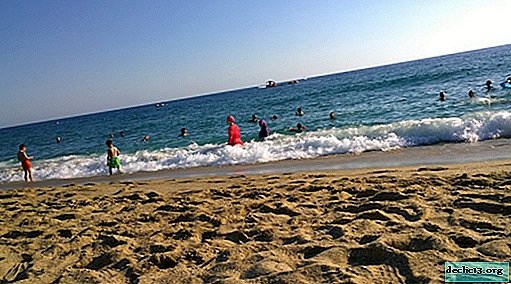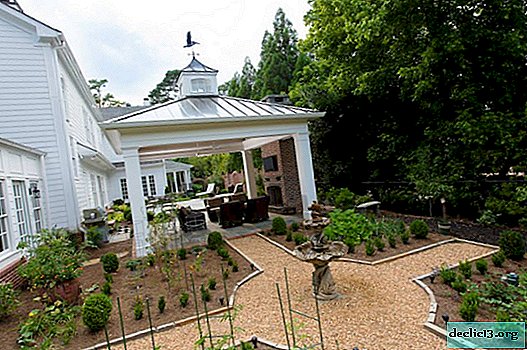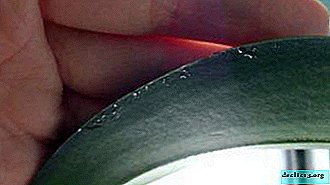Dutch cuisine - national dishes of the Netherlands
God gave the Dutch nothing but water. They learned to do the rest with their own hands - and not only build bridges and dams, but also catch and salt herring, boil cheese and beer, grow tulips, discover new lands, win and prepare the dishes of the winners.

Features of national cuisine
Although the Dutch have not so many culinary discoveries. The national cuisine of the Netherlands is characterized by moderate use of spices, simple and affordable ingredients and a rather concise design. The terms "refined" and "refined" - this is not about her. It has been noticed for a long time: the Dutch do not eat, do not invent anything - they just eat. Or just eat. This is how you like it. Fish and seafood, meat, dairy products (including world-famous cheese), potatoes and other vegetables - these are the basis of simple and satisfying Dutch cuisine.

But at the same time, on the festive table they have dishes that are unusual in taste, in which the most different and sometimes unexpected shades are combined. For example: berry, apple and ginger sauces for meat, fish in a honey marinade, original licorice candies, which can be either sweet or salty.
What do people in the Netherlands eat every day?

The main meal is for dinner, even soups can be served in the evening. Breakfast and lunch among the inhabitants of the Netherlands mainly consists of various sandwiches and toasts - cold and hot, tea and coffee with dessert. Busy people and tourists, even on the street, can have a bite to eat, hearty and not very expensive for 6-8 euros.
To understand how easy the Dutch national dishes are to prepare, it is worth cooking at least one of them yourself, for example, any soup.
You will be interested in: Where to eat in Amsterdam - an overview of the best restaurants and budget establishments.
Soups
In the Netherlands, they are cooked both in water and in saturated broth, using several types of meat and sausages in one dish. Of vegetables, soups use onions, carrots, celery or potatoes, different types of cabbage and tomatoes. Dressing can be made from eggs, as well as cream, cheese and other dairy products. When serving, soups are decorated with greens. As a basis for preparing soups of Dutch cuisine, peas are especially respected.
Erwtensoep or Snert - Dutch Pea Soup
One of the few Dutch dishes that can be said to be known around the world. But, like each of our housewives, preparing borsch or cabbage soup, has its own secrets and tricks, there are quite a few recipes for preparing pea soup in the Netherlands - several dozen. Perhaps the only thing that distinguishes them a little from the familiar and also familiar to us tasty soup is that among the ingredients there is usually no potato. And the dish itself turns out to be very thick, like mashed potatoes or porridge, so that the spoon stands.
Main product: dry chopped peas. To prepare several servings of soup take:
- about 300 g peas,
- one large (or 2 small) bulbs and carrots
- 4-6 stalks of celery
- 150 g of fresh and smoked bacon and 250 g of smoked sausage
- seasonings - salt, pepper (or "Vegeta"), bay leaf

Peas are soaked for several hours (usually at night), washed and cooked until the initial softness, removing the foam. Then, chopped vegetables and a slice of bacon are put into the pan. The shape of the cuts can be any. Add bay leaf, seasonings, and if necessary - water or ready-made broth. The broth can be made from pork shank or ribs. But this is an option, in the basic version you can do with water. Liquids are added to cover vegetables.

Further, you need to cook the soup until the carrots are ready, and then turn everything into mashed potatoes - with a whisk or a blender, without forgetting to remove the bay leaf before that. The final stage of preparation of this national dish of the Netherlands is another 5-7 minutes to boil the mixture, adding chopped pieces of smoked sausage to it. The soup should be infused, although freshly prepared it is already tasty and satisfying.
They eat pea soup with smoked bacon, laid on pieces of rye bread.
Dutch celery soupIn warm summertime, this soup is rarely prepared in Holland - more in winter, in early spring and late autumn - when it's cold. More often this is not a dinner dish, but an evening one, it is eaten for dinner when the whole family gathers. And be sure to cook a lot of pea soup for Christmas.
Ingredients for 1 serving of soup:

150-200 g celery root, 1 onion, 2 tbsp of butter, 1 tbsp of flour, 500 g of meat broth, 1 egg, 50 g of sour cream, herbs, ½ tablespoon of lemon juice, salt, pepper.
Grate the celery, chop the onion finely and fry together with celery in butter, add flour, salt and mix. Pour the broth into the pan and bring everything to a boil.
Sauce: Beat the yolk with sour cream and add a little lemon juice.
Pour into hot soup before serving and put chopped greens on top. In such a soup, you can add a piece of boiled fish or meat, on which the broth was cooked.
Snacks
Appetizers in the Netherlands are mostly cold and hot sandwiches, canapes or skewers. Ham, bacon, fried eggs are placed on bread and seasoned with mayonnaise, ketchup or mustard, or even all together. Fish is a separate issue. In addition to herring, they eat mackerel, smoked eel and fried cod. Meet some of the most popular Dutch cuisine snacks.
Harring - Herring in Dutch
Herring, jokingly called "Dutch sushi", is truly Holland's national food. A country conquered from the sea, she gave fame no less than cheese, and is considered the second gastronomic symbol of the West European state of the Netherlands.
The Dutch say that it is raw, but it is not. Freshly caught fish is first quickly frozen for exactly one day (this technique also helps to decontaminate the catch), and then it is immediately salted or pickled in a special marinade. Surely there are some special secrets in the process. After a couple of days, the delicacy is ready to eat and literally melts in your mouth.
How to eat a Dutch herringHerring can be served chopped, sliced, just with slices of white bread. Or in the same form in a sandwich, sprinkled with hot fried onions.


The young herring of the first catch ("Hollandse Nieuwe"), after being previously rolled in chopped onion into small cubes, is eaten without being cut into pieces.
Throwing back his head and holding the fish by the tail, they try to send it to the mouth in its entirety. Usually washed down with beer.
Bitterballen - BitterbalenInteresting Facts. The Dutch dedicated their favorite food to a separate holiday - Vlaggetjesdag (Flag Day), which marks the beginning of the herring season. It is celebrated every year on the first June day off.

Veal meat croquettes. They can be cylindrical, or in the form of balls (large meatballs).
Features of the preparation: ground nutmeg must be added to the minced meat, and before frying, roll in the egg and breadcrumbs and freeze briefly. Fried cold croquettes in hot deep fat. This produces a crisp, and in the middle - juicy meat. Croquettes are good in both hot and chilled form.
Bitterballen is an irreplaceable beer snack; it is always present in all bars and cafes. Croquettes with various sauces are also served at receptions and during cocktails.
PatatFrench fries, but not thin straws, but larger slices. This popular snack can be bought here at every corner. It is usually sold in a bag, a craft bag or other packaging, and may be complete with a sauce of your choice.

The most requested sauce for this dish (but not very appetizing in appearance) is raw pickled onions, seasoned with a mixture of mayonnaise and peanut sauce.
Main dishes
As for the hot, in the Dutch cuisine vegetables are cooked in the form of stew: stewed, steamed and baked. The most popular meat dishes are sausages, sausages and various meat balls and croquettes. They can be both an appetizer and a hot dish, served with a side dish.
Hutshot and StamppotBy and large, these are different variations and combinations of the same national dish of the Netherlands. Only the first of them, Hoedspot or Hutspot, is the full version, including a side dish and meat component. But Stampot or Stamppot (stamppot) - actually the vegetable side dish itself, the main ingredients of which are potatoes, carrots and onions (a classic set) in the form of not very carefully ground mashed potatoes.

But there are secrets in the recipe for even such a seemingly simple dish - each cook or hostess has their own.

In addition to the main named set of vegetables, the garnish can be used: cabbage of all types and varieties, parsnips, celery roots, together with them or in any combination.
The meat addition to the dish can be very different: boiled, stewed or stewed meat, sausage - smoked, boiled and sausages, or meat balls.
The dish is hearty, high-calorie and with a story. In Leiden, it must be cooked every year on October 3. In 1574, during the well-known Eighty-Day War, it was on this day that dams were opened, the Spaniards besieging the city were carried off to sea, and the long siege ended.
In an abandoned Spanish camp, residents found a huge cauldron with a prepared dish with approximately the same composition. This saved them from starvation before the arrival of the first ships with provisions from William of Orange. Then a similar dish began to be prepared in Holland, and carrots in it - as a symbol of the orange-yellow flowers of the Oransky house.
Gestoofde kool met gerookte worst - Braised cabbage with sausage
Sausage in the Dutch version of this popular dish in different countries is smoked. Cabbage can be ordinary white, Brussels sprouts or a mixture of its various species, even kohlrabi. To give an original taste, several juniper berries and peppers are sure to be added.
Kip met notensaus (saté) - Chicken with peanut sauceAlthough this dish comes from colonial times, possibly Indonesian, it can be found in almost every restaurant or cafe in the Netherlands.

Grilled pieces of chicken cooked on a grill or pan are poured with a delicious sauce made from a mixture of peanut butter and soy sauce with olive oil and honey.
Served with various leafy salads or with tomatoes.
Interesting! Peanut butter is extremely popular in the Netherlands, sold and served everywhere. However, it is quite simple to do it yourself: grind 250 g of dried peanuts into powder or small crumbs and combine them with several tablespoons of olive oil, honey or sugar to taste, add salt on the tip of the knife. Whip everything in a blender.
Read also: What to buy in Holland for a gift to relatives?
Dessert
Residents of the Netherlands love sweets. Some Dutch desserts look so appetizing and sometimes pretentious that there is no point in resisting the desire to try them. Although the local sweets are not much more difficult to prepare than the main dishes of Dutch cuisine.
And let's start with the simplest Dutch treat, which is not even eaten for dessert, and sometimes, with a cup of tea or coffee, it is replaced by breakfast or even lunch.
Hagelslag HahelslachHahelslach is just pieces of bread sprinkled with chocolate chips. And the bread, and the crumb itself can be of very different varieties and types and even colors.
 Vlaai - thin round cake
Vlaai - thin round cakeIn the southern provinces, Brabant and Limburg love the Vlaai cake. The filling for it can be any fruit or berries.

It’s easy to bake such a pie on your own, but it’s even easier to buy or order in the “MultiVlaai” network, which has more than a hundred branches in the country and its own online store. The assortment of almost 50 types of this delicious treat.
Appeltaart met slagroom - Dutch apple pieThe king of Dutch desserts is an open apple pie with cinnamon and whipped cream. The recipe for its preparation is passed on from generation to generation.

Appeltaart can be bought in many bakeries, pastry shops and cafes, and it is better to eat while the cake is still warm: this reveals the aroma of apples and cinnamon. When cold, a cooled Dutch apple pie is good along with ice cream.
Pepernoten - Gingerbread cookie
This small light brown cookie, similar to round sweets with a diameter of 1 cm - a seasonal Dutch treat, appears in candy stores and shops at the very beginning of December. He is being prepared for the holiday of Sinterklaas (St. Nicholas).
Stroopwafels - Dutch WafflesTwo thin crispy waffles glued with caramel syrup are good for coffee or tea. And these waffles have one funny purpose - they serve as a lid for a tea or coffee cup during tea drinking.
What do the Dutch drink

First of all, according to a long tradition, such "colonial goods" as tea and coffee.
From 10 to 11 in the morning and from 7 to 8 in the evening in the Netherlands - koffietijd ("coffee time").
If you do not drink coffee at home, but in a cafe, then by default each cup has a small cookie or a cupcake. In addition to black, koffie verkeerd - coffee with milk is also popular. In the Netherlands it is called "wrong", but they drink no less.
In the cold season, they like to drink hot chocolate and milk with anise. Another drink worth mentioning is lemonade, which is drunk warm (kvast).
Alcoholic drinks - Dutch beer and liqueurs Jenever
The most famous national brands of beer: Heineken, Grolsch and Amstel. Unlike huge German glasses, beer in the Netherlands is poured into small ones, with a capacity even less than our standard glass - so it does not have time to heat up and retains its amazing signature taste.
If you immediately drink Dutch beer with gin (there are many lovers of such a combination), the result is close to the “infernal mixture” familiar to our compatriots: beer + vodka. The local mixture is called kopstoot - “head smasher” or “head punch”.

But much earlier than the English gin, it was in Holland in the 17th century that they came up with a composition that later, having undergone some improvements in the recipe, became the most popular strong drink in the Netherlands. This is Jenever (or Genever, Enever).
Barley, corn, rye and juniper berries with certain spices are the main composition of the liquor. Our tourists call it simply juniper vodka. Depending on the exposure, the drink has a different strength - from 30 to 48 degrees and, accordingly, the cost.
It also differs in taste: from a sharp young jonge to a pleasant old oude. The young genever is colorless, it is often used for making cocktails, and the old, light brown, is used in its pure form.

The most expensive type of this drink Korenwijn (Korenvayn) - dense and oily, it is sold in ceramic bottles. Another species, Graanjenever, is made only from cereals.
The national drink of the Netherlands Genever drink from tulip-shaped glasses.
The most famous producer of this and other liquors in the Netherlands is Bols.
On a note: Coffee Shops in Amsterdam - What You Need to Know.
Compare accommodation prices using this form
What else you must definitely try in the Netherlands
Liquorice candy
Caterpillars, rods, shoelaces and skipper tubes - doesn’t it sound very tasty somehow? Nevertheless, these are some names from a large assortment of classic licorice sweets, the main "eaters" of which are in Holland. Here they are produced.
"Drop" - dark sweets from licorice root, very useful - they have antibacterial properties, soothe nerves and protect against tooth decay.
They remind you of marmalade in taste, in the “children's” version they are produced in the form of various “animal toys”, but at the same time they are both sweet and very salty and bitter, therefore they are not to the taste of most tourists.
But the Dutch themselves eat this "black gold" at 4 kilograms per year.
Dutch cheeseAnd finally, about the cheese. In the Netherlands, this is not only a dessert.It can be found in soup and salads, cheese can be baked, eat with pineapples and ham, even with fish.

The range of gastronomic symbols of the Netherlands and all Dutch cuisine is huge, but the most recognized and famous varieties:
- semi-solid Edammer (Edam) in the form of a "cheese head" (kaaskop) coated with red paraffin
- solid Goudse (Gouda) light yellow with holes and creamy taste
- hard Maasdam (Maazdam), pale yellow with a nutty taste and large eye cavities.
 Maasdam
MaasdamEach variety has an original and unique taste and, depending on the aging, it happens: young, half-mature and mature. Cheese aged about a year is considered old. He acquires only his characteristic qualities, which are appreciated by many lovers and experts.
In addition to the usual "yellow cheese", delicious cheeses with additives: caraway seeds, mustard seeds, cloves and other spices are produced.
And no matter where the Dutch cheese is made - at a dairy or farm, everywhere it is equally tasty.
The Netherlands is the world's largest exporter of cheese - of the more than 700 million kg of product produced annually in the country, ¾ is exported.

















